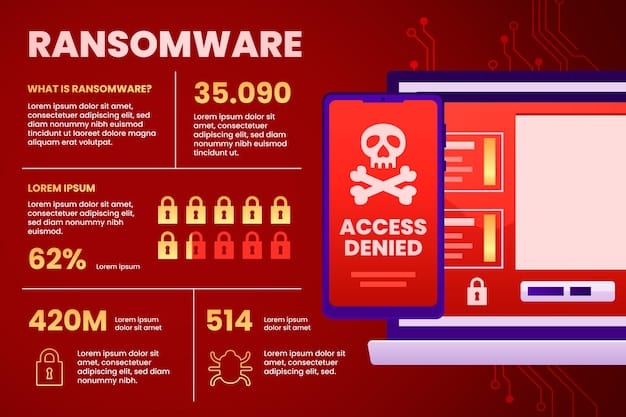Cybersecurity Alert: 3 Critical Vulnerabilities Affecting US Businesses

US businesses face heightened cybersecurity risks due to three critical vulnerabilities that could compromise sensitive data and disrupt operations, demanding immediate attention and remediation.
A new Cybersecurity Alert: 3 Critical Vulnerabilities Affecting US Businesses Right Now demands immediate attention. These threats could expose sensitive data and disrupt critical operations if left unaddressed.
Understanding the Current Cyber Landscape in the US
The digital landscape in the United States is constantly evolving and becoming more complex, and so is the threat landscape, where cyberattacks have become more frequent and sophisticated, causing significant financial and reputational damage to businesses across various sectors.
Understanding the current cyber landscape and threats is the first step to protecting your company and your data.
Increased Frequency and Sophistication of Attacks
One of the most notable trends is the increasing frequency and sophistication of cyberattacks. Attackers are constantly developing new methods to bypass security measures and exploit vulnerabilities.

- Phishing attacks are becoming more targeted and difficult to detect.
- Ransomware attacks are growing in scale and impact.
- Supply chain attacks are becoming more prevalent and difficult to defend against.
Businesses need to stay informed about these evolving threats and take proactive measures to protect their systems and data.
The proliferation of new attack vectors also increases the risk of cyber threats. The rise of cloud services and IoT devices has created new entry points for attackers to exploit.
Staying informed and vigilant is essential to protecting your company.
Critical Vulnerability #1: Unpatched Software
One of the most common and easily exploitable vulnerabilities is unpatched software. Many businesses fail to keep their software up to date, leaving them vulnerable to known exploits.
This creates opportunities for attackers to gain unauthorized access and compromise systems.
The Risks of Outdated Software
Outdated software often contains known security flaws that attackers can easily exploit. Once a vulnerability is discovered, attackers can quickly develop and deploy exploits to target vulnerable systems.
Failing to patch software promptly leaves your business at risk of being compromised.
- Attackers scan networks for vulnerable systems.
- Exploit known vulnerabilities in outdated software.
- Gain unauthorized access to sensitive data and systems.
Regularly patching software is a simple yet highly effective way to mitigate this risk.
In addition to known vulnerabilities, outdated software may also lack the latest security features and protections. This can make it easier for attackers to bypass security measures and gain access to systems.
Keeping software up to date ensures that you have the best possible protection against emerging threats.
Critical Vulnerability #2: Weak or Stolen Credentials
Weak or stolen credentials are another major vulnerability that can lead to security breaches. Many users still use weak passwords or reuse the same password across multiple accounts, making it easier for attackers to gain unauthorized access.
Once an attacker has obtained valid credentials, they can use them to access sensitive data and systems.
Password Management Best Practices
Implementing strong password management policies is essential for protecting against credential-based attacks. Encourage users to create strong, unique passwords and to use a password manager to store and manage their credentials.

- Use strong, unique passwords for each account.
- Enable multi-factor authentication (MFA) whenever possible.
- Use a password manager to store and manage credentials securely.
Regularly auditing user accounts and access privileges can also help to identify and prevent unauthorized access.
Implementing multi-factor authentication (MFA) adds an extra layer of security by requiring users to provide two or more forms of authentication before granting access.
Even if an attacker obtains a user’s password, they will still need to provide an additional form of authentication to gain access.
Critical Vulnerability #3: Phishing Attacks
Phishing attacks continue to be a highly effective way for attackers to steal credentials and deploy malware. These attacks often involve sending emails or text messages that appear to be from a legitimate source, such as a bank or social media platform.
The goal is to trick users into clicking on a malicious link or providing sensitive information.
How to Spot and Avoid Phishing Attempts
Educating employees about phishing attacks is essential for preventing them from falling victim to these scams. Teach employees how to identify and avoid phishing attempts by looking for red flags, such as suspicious email addresses, grammatical errors, and urgent requests for information.
Simulating phishing attacks can also help to identify employees who may be more vulnerable to these scams.
- Verify the sender’s identity before clicking on links or providing information.
- Be wary of emails with urgent requests for information.
- Look for grammatical errors and suspicious language.
Implementing email security measures, such as spam filters and anti-phishing software, can also help to block malicious emails from reaching users.
Always be cautious when clicking on links or providing sensitive information online.
Immediate Actions for US Businesses to Take
To mitigate these critical vulnerabilities, US businesses need to take immediate action. This includes implementing robust security measures, educating employees, and staying informed about the latest threats and vulnerabilities.
Taking proactive steps now can help to protect your business and your data from cyberattacks.
Strengthening Your Security Posture
Strengthening your security posture involves implementing a range of security measures, including firewalls, intrusion detection systems, and endpoint protection software.
Regularly assessing your security posture can help to identify and address any weaknesses or vulnerabilities.
Conduct vulnerability assessments and penetration testing to identify any weaknesses in your systems and networks. Implement a comprehensive security awareness training program to educate employees about security best practices.
By taking these steps, you can significantly reduce your risk of being compromised by a cyberattack.
Staying informed about the latest threats and vulnerabilities is also essential for maintaining a strong security posture. Subscribe to security newsletters and alerts to stay up to date on emerging threats and vulnerabilities.
Promptly apply security patches and updates to address any known vulnerabilities.
Google Search Console
Cyber incidents are a growing threat to US businesses. It’s best to be prepared.
Ransomware attacks lead to data breaches, financial losses, and reputational damage.
US companies are required to comply with federal and state data privacy regulations.
Cybersecurity Alert: 3 Critical Vulnerabilities Affecting US Businesses Right Now
Cybersecurity breaches can lead to data theft and operational disruptions.
Promptly patching software reduces vulnerabilities and mitigates security risks.
Use strong, unique passwords and multi-factor authentication to prevent unauthorized access.
Phishing attacks can trick users into revealing sensitive information or downloading malware.
[Understanding the current threats and mitigation techniques]
▼
The most common cyber threats include phishing attacks, malware infections, ransomware incidents, and distributed denial-of-service (DDoS) attacks which can affect businesses’ sensitive data and critical systems.
▼
Prioritizing cybersecurity is crucial because it protects valuable assets, maintains customer trust, minimizes financial losses from cyber incidents, ensures compliance with data protection regulations, and safeguards a company’s reputation.
▼
Businesses can enhance cybersecurity by implementing strong, unique passwords for all accounts, enabling multi-factor authentication, regularly updating software, educating employees, and deploying trusted antivirus solutions.
▼
Businesses should conduct security audits and vulnerability assessments regularly, ideally on a quarterly or bi-annual basis, to identify and address any weaknesses in their systems and networks proactively.
▼
Employee training is essential for cybersecurity as it educates staff on recognizing phishing attempts, handling sensitive data securely, and reporting suspicious activities, fostering a culture of vigilance across the organization.
Conclusion
In conclusion, addressing these three critical vulnerabilities—unpatched software, weak credentials, and phishing attacks—is crucial for US businesses to protect themselves against the evolving cybersecurity landscape. By implementing robust security measures, educating employees, and staying informed about the latest threats, organizations can significantly reduce their risk of falling victim to cyberattacks and safeguard their valuable assets and reputation.
Read more content





